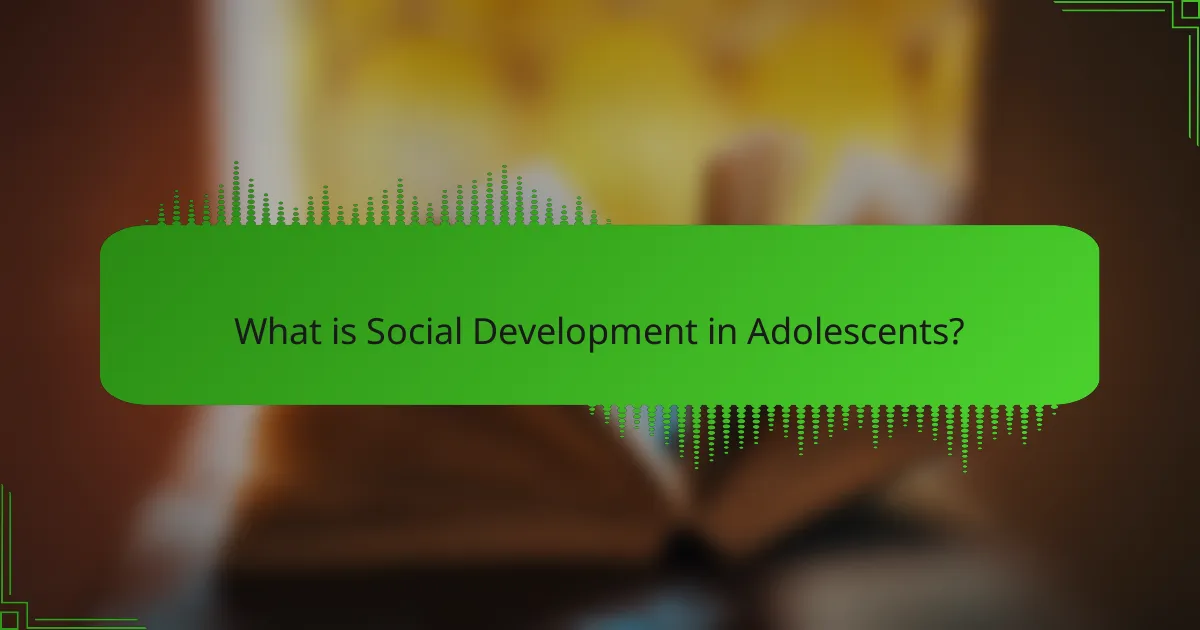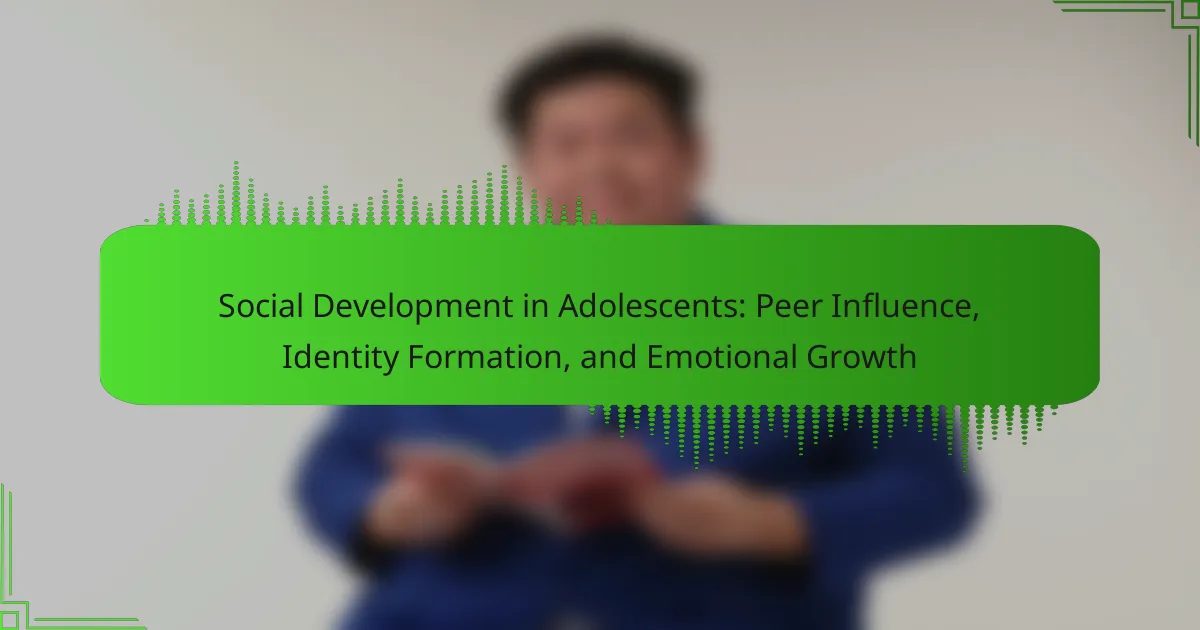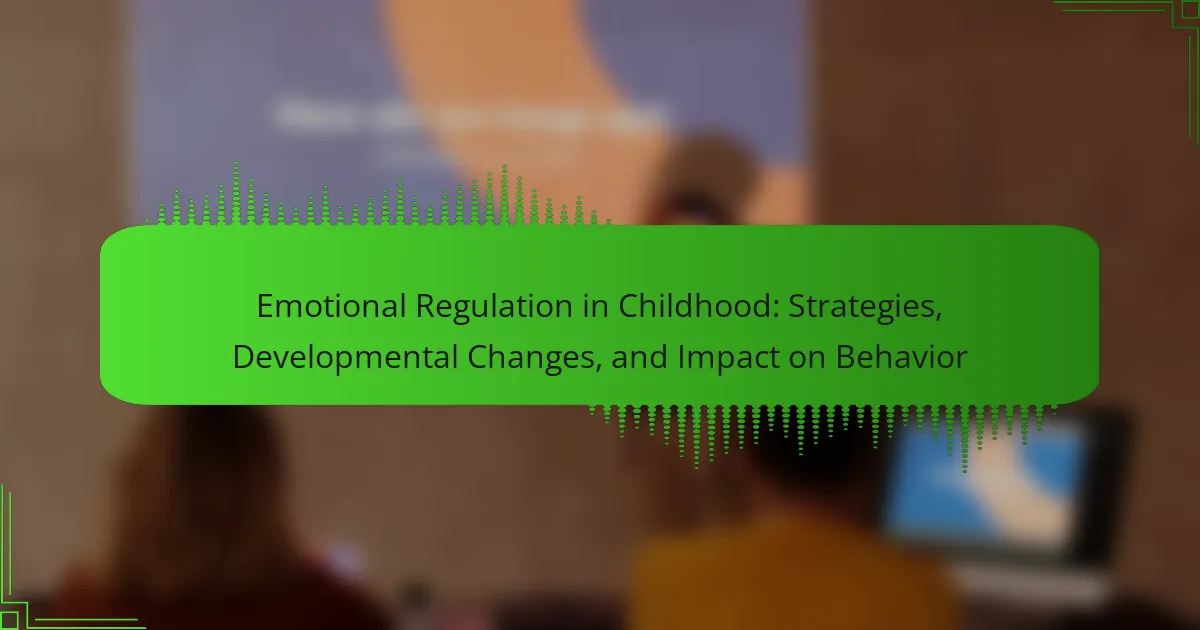Social development in adolescents encompasses the process through which young individuals learn to engage with others and build relationships, a crucial aspect during the transformative years of adolescence. This period is characterized by a growing desire for independence, identity formation, and the increasing importance of peer relationships. Positive social interactions during this time are linked to enhanced emotional well-being, higher self-esteem, and lower rates of mental health issues. Peer influence plays a significant role in shaping identity, as adolescents often seek validation from their peers, which can lead to the adoption of group behaviors and values. Additionally, family dynamics and cultural context are vital in influencing social skills and emotional outcomes, highlighting the multifaceted nature of social development in this age group.

What is Social Development in Adolescents?
Social development in adolescents refers to the process by which young individuals learn to interact with others and form relationships. This development is crucial during adolescence, a period marked by significant social changes. Adolescents begin to seek independence from their families and establish their own identities. Peer relationships become increasingly important, influencing behaviors and attitudes. Social skills, such as communication and empathy, are developed during this time. Research shows that positive social interactions can lead to better emotional well-being. According to the American Psychological Association, strong social connections during adolescence are linked to higher self-esteem and lower rates of mental health issues.
How does peer influence shape social development during adolescence?
Peer influence significantly shapes social development during adolescence. Adolescents often seek acceptance and validation from their peers. This desire can lead to changes in behavior, interests, and social dynamics. For example, engaging in group activities fosters collaboration and communication skills. Additionally, peer interactions can enhance emotional intelligence through shared experiences. Research indicates that adolescents who have strong peer relationships tend to exhibit better social skills. A study by Brown et al. (1999) found that peer influence is a critical factor in identity formation during this developmental stage. Furthermore, positive peer relationships can promote healthy risk-taking behaviors, while negative influences may lead to detrimental outcomes. Thus, peer influence is a fundamental aspect of social development in adolescence.
What are the different types of peer influences experienced by adolescents?
Adolescents experience several types of peer influences. These include normative influence, informational influence, and peer pressure. Normative influence occurs when adolescents conform to group norms to gain acceptance. Informational influence happens when they look to peers for guidance in uncertain situations. Peer pressure can be positive or negative, encouraging behaviors such as risk-taking or prosocial actions. Research shows that these influences significantly impact adolescents’ decision-making and identity formation. For instance, a study by Steinberg and Monahan (2007) found that peer influences peak during mid-adolescence, affecting choices related to substance use and social behaviors.
How do positive and negative peer influences affect adolescent behavior?
Positive peer influences encourage healthy behaviors in adolescents. They promote academic achievement, social skills, and emotional support. For example, friends who prioritize studying can motivate each other to perform better in school. Conversely, negative peer influences can lead to risky behaviors. These may include substance abuse, delinquency, and poor academic performance. Research shows that adolescents are more likely to engage in risky behaviors when surrounded by peers who endorse such actions. A study published in the Journal of Youth and Adolescence found that peer pressure significantly impacts decision-making during this developmental stage. Thus, the influence of peers plays a crucial role in shaping adolescent behavior.
What role does identity formation play in adolescent social development?
Identity formation is crucial in adolescent social development. It shapes how adolescents perceive themselves and interact with peers. As adolescents explore their identities, they develop a sense of belonging. This belonging influences their social relationships and peer dynamics. Identity formation also affects self-esteem and confidence. Research shows that a strong identity correlates with healthier social interactions. Adolescents with clear identities are more likely to engage positively with peers. They are better equipped to navigate social challenges.
What are the stages of identity development in adolescents?
The stages of identity development in adolescents include several key phases. These stages are often defined by Erik Erikson’s theory of psychosocial development. The first stage is identity diffusion, where adolescents lack direction and are unsure of their identity. The second stage is identity foreclosure, where they commit to an identity without exploring other options. The third stage is identity moratorium, characterized by active exploration and questioning of identity. The final stage is identity achievement, where adolescents have explored options and made commitments to their identity. Research supports these stages as crucial for healthy psychological development during adolescence.
How do social interactions contribute to identity formation?
Social interactions significantly contribute to identity formation by providing individuals with feedback and social cues. Adolescents engage with peers, family, and community members, which influences their self-perception. These interactions help shape values, beliefs, and behaviors. For example, studies show that peer acceptance can reinforce certain traits, while rejection can lead to self-doubt. Additionally, social interactions allow adolescents to explore different roles and identities in a safe environment. Research by Erikson emphasizes that social relationships are crucial during the identity vs. role confusion stage. This developmental process fosters a sense of belonging and individuality. Ultimately, social interactions are integral in helping individuals construct their unique identities.
How does emotional growth manifest in adolescents?
Emotional growth in adolescents manifests through increased self-awareness and improved emotional regulation. They begin to understand their feelings and recognize their impact on behavior. Adolescents often develop empathy, allowing them to connect with others’ emotions. This stage also includes enhanced coping strategies for stress and conflict. Research shows that social interactions play a crucial role in this growth. Peer relationships provide opportunities for emotional expression and support. Adolescents learn to navigate complex social dynamics, which fosters resilience. Studies indicate that emotional intelligence during this period predicts future mental health outcomes. Overall, emotional growth is a vital aspect of adolescent development, shaping their interactions and relationships.
What are the key emotional milestones during adolescence?
Key emotional milestones during adolescence include the development of self-identity, increased emotional regulation, and enhanced empathy. Adolescents begin to form a clearer sense of who they are. This process often involves exploring different roles and values. Emotional regulation improves as they learn to manage their feelings more effectively. This skill is crucial for handling stress and peer pressure. Empathy also deepens, allowing them to understand others’ perspectives better. Research indicates that these milestones contribute significantly to social relationships and mental health outcomes. Studies show that adolescents with strong emotional skills are more likely to engage positively with peers.
How do relationships with peers impact emotional development?
Relationships with peers significantly impact emotional development. They provide a platform for social interaction and emotional support. Positive peer relationships can enhance self-esteem and promote emotional resilience. Adolescents learn to navigate complex emotions through peer interactions. They gain skills in empathy and conflict resolution. Research shows that supportive friendships correlate with lower levels of anxiety and depression. Additionally, peer relationships influence identity formation and self-concept. The quality of these relationships often dictates emotional well-being during adolescence.

What are the connections between peer influence and identity formation?
Peer influence significantly impacts identity formation during adolescence. Adolescents often seek acceptance and validation from their peers. This desire can lead to adopting behaviors, values, and beliefs that align with their social group. Research indicates that peer interactions help shape self-concept and identity. For instance, a study by Brown et al. (1994) found that peer relationships contribute to the development of personal identity. Additionally, peer feedback can reinforce or challenge an adolescent’s self-perception. This dynamic fosters exploration and experimentation with different aspects of identity. Ultimately, peer influence serves as a critical context for adolescents to navigate their identities.
How do peers contribute to the identity exploration process?
Peers significantly contribute to the identity exploration process during adolescence. They provide social feedback that helps individuals understand themselves better. Interactions with peers allow adolescents to experiment with different roles and behaviors. This experimentation is crucial for self-discovery and personal growth. Peer groups often reflect diverse perspectives and values. Exposure to these varying viewpoints encourages critical thinking about one’s own beliefs. Additionally, peers can offer support and validation during this exploration. Research indicates that peer relationships are essential for developing a sense of belonging. These dynamics play a vital role in shaping identity during formative years.
What challenges do adolescents face in balancing peer influence and personal identity?
Adolescents face significant challenges in balancing peer influence and personal identity. The desire for acceptance can lead to conformity, which may compromise their authentic selves. Peer pressure often encourages risky behaviors, such as substance use or unhealthy relationships. Adolescents may struggle to assert their individuality while also wanting to fit in with their social groups. This conflict can result in anxiety and low self-esteem. Research indicates that identity formation is crucial during adolescence, making this balance even more critical. A study by Erikson (1968) highlights the importance of navigating these influences to develop a strong sense of self. Overall, the interplay between peer influence and personal identity poses considerable challenges for adolescents.

What specific factors influence social development in adolescents?
Peer relationships, family dynamics, and cultural context significantly influence social development in adolescents. Peers provide a platform for social interaction and identity exploration. Family support shapes self-esteem and emotional resilience. Cultural norms affect social behaviors and expectations. Research shows that positive peer interactions enhance social skills. Studies indicate that supportive family environments lead to better emotional outcomes. Additionally, cultural influences can either promote or hinder social integration.
How does family background affect peer relationships?
Family background significantly affects peer relationships. Adolescents from supportive families tend to form healthier friendships. They often exhibit higher self-esteem and better social skills. Conversely, those from dysfunctional backgrounds may struggle with trust and communication. Research indicates that family dynamics influence social behavior. A study by Quatman et al. (2001) found that family support correlates with positive peer interactions. Additionally, socioeconomic status impacts access to social networks. Families with resources provide opportunities for social engagement. This creates a wider circle of friends and influences peer acceptance.
What role does parental involvement play in adolescent social development?
Parental involvement plays a crucial role in adolescent social development. It influences the development of social skills and emotional well-being. Adolescents with engaged parents tend to have better peer relationships. They often demonstrate improved communication skills. Research indicates that parental support contributes to higher self-esteem in teenagers. A study by the American Psychological Association found that adolescents with involved parents are more likely to exhibit positive social behaviors. This involvement can include monitoring activities and fostering open communication. These factors collectively enhance an adolescent’s ability to navigate social situations effectively.
How do cultural factors influence peer dynamics?
Cultural factors significantly influence peer dynamics by shaping values, behaviors, and social norms. These factors determine how adolescents interact with each other. For instance, collectivist cultures promote group harmony and cooperation among peers. In contrast, individualistic cultures encourage competition and personal achievement. Cultural expectations also dictate acceptable behaviors within peer groups. Research shows that adolescents from diverse cultural backgrounds exhibit different conflict resolution styles. A study by Chiu et al. (2017) found that cultural context affects friendship formation and maintenance. Thus, understanding cultural influences is essential for comprehending peer dynamics in social development.
What strategies can support healthy social development in adolescents?
Promoting healthy social development in adolescents involves several effective strategies. Encouraging open communication fosters trust and emotional expression. Engaging adolescents in group activities helps build teamwork and social skills. Providing mentorship opportunities connects them with positive role models. Teaching conflict resolution equips them with essential problem-solving abilities. Encouraging participation in community service instills a sense of belonging and responsibility. Supporting peer relationships enhances their social networks and emotional well-being. Research shows that adolescents with strong social support systems are more resilient and better equipped to handle stress. These strategies collectively contribute to a well-rounded social development during adolescence.
How can schools foster positive peer interactions?
Schools can foster positive peer interactions by implementing structured programs that promote collaboration and communication. These programs can include team-building activities and group projects. Research shows that cooperative learning enhances social skills and reduces conflict. Schools can also create safe spaces for students to express themselves. Peer mentoring programs encourage older students to guide younger ones. Regular workshops on empathy and conflict resolution can further enhance understanding among peers. Schools that promote inclusivity and diversity see improved peer relationships. According to a study by the Collaborative for Academic, Social, and Emotional Learning, social-emotional learning programs significantly boost positive interactions among students.
What practices can parents adopt to encourage emotional growth in their adolescents?
Parents can encourage emotional growth in their adolescents by fostering open communication. This practice allows teens to express their feelings without fear of judgment. Active listening is crucial; it shows adolescents that their emotions are valid. Encouraging problem-solving skills helps teens navigate their emotions effectively. Parents should model emotional regulation, demonstrating healthy coping strategies. Providing a supportive environment promotes resilience in facing challenges. Setting aside quality time strengthens the parent-teen bond, enhancing emotional security. Research indicates that supportive parenting correlates with better emotional outcomes in adolescents.
Social development in adolescents encompasses the processes through which young individuals learn to interact, form relationships, and establish identities during a critical developmental phase. The article examines the significant role of peer influence in shaping social skills, identity formation, and emotional growth, highlighting both positive and negative impacts on adolescent behavior. It outlines various types of peer influences, the stages of identity development, and the emotional milestones adolescents experience. Additionally, the article discusses the influence of family dynamics and cultural factors on social interactions, while offering strategies for promoting healthy social development in adolescents through supportive relationships and effective communication.



